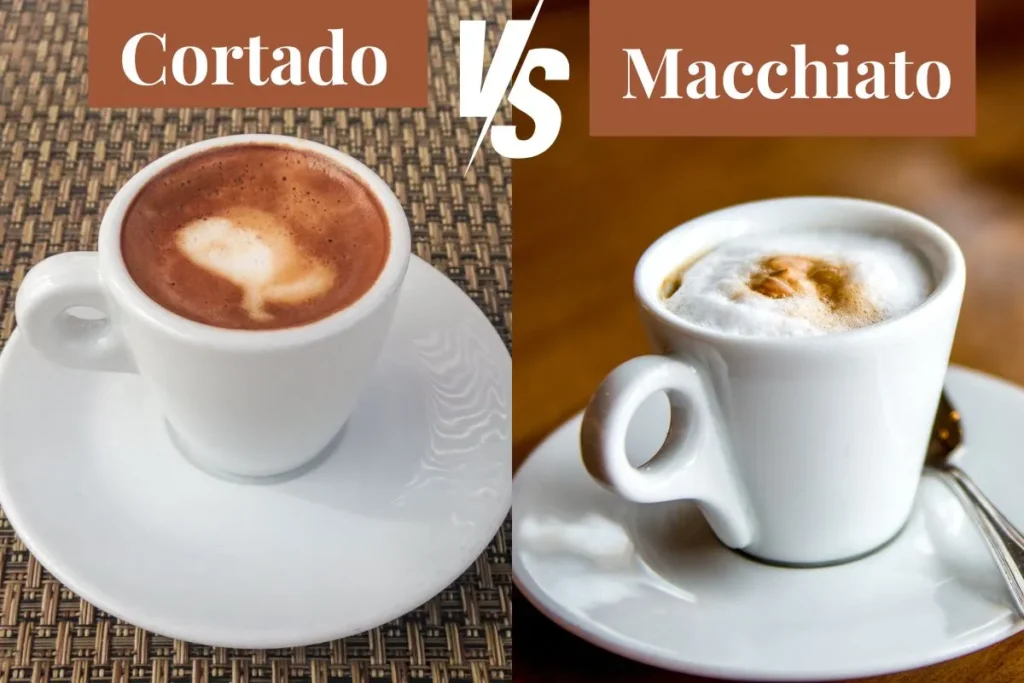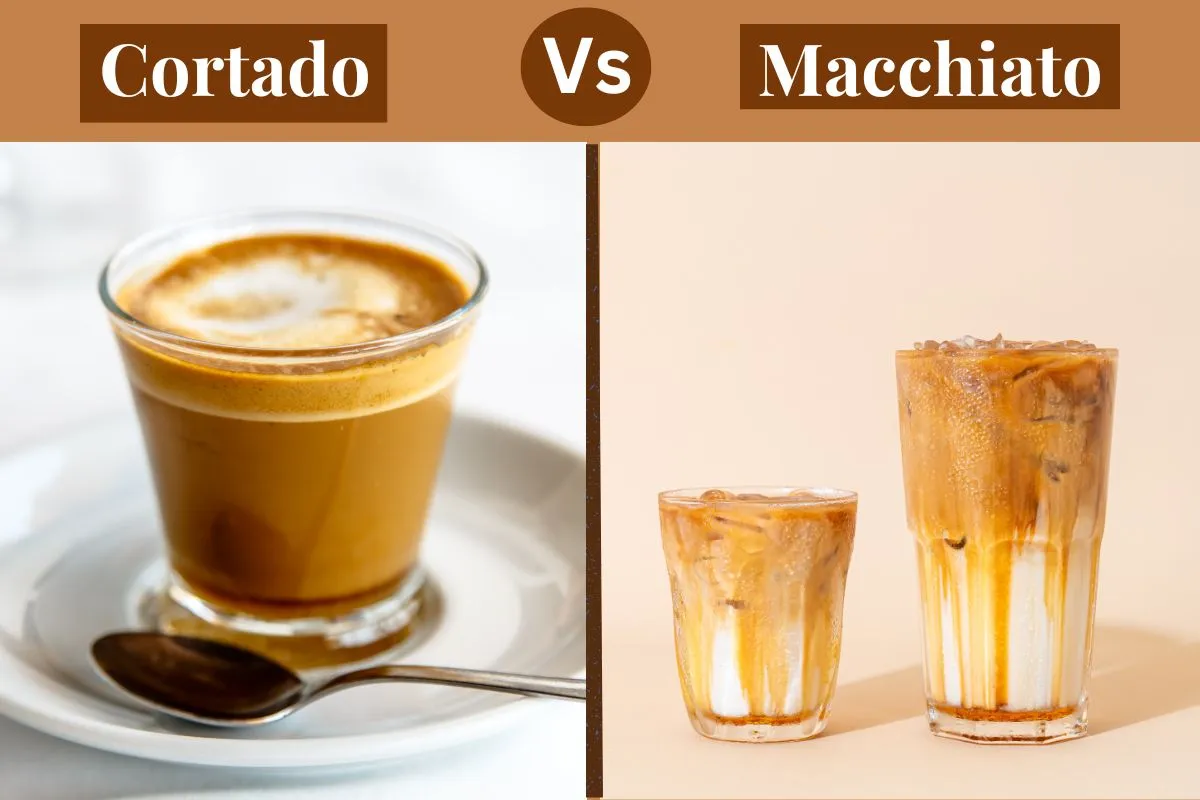Two espresso drinks stand out among the rest: the Cortado and the Macchiato. While seemingly similar, these beverages offer unique experiences for coffee lovers. In this guide, we’ll uncover their origins, preparation methods, and distinct flavor profiles. Whether you prefer a robust and balanced coffee or a quick espresso hit with a touch of sweetness, by the end, you’ll know exactly which drink suits your taste.
Cortado vs Macchiato
| Feature | Cortado | Macchiato |
|---|---|---|
| Origin | Spain, early 1960s | Italy |
| Cultural Context | Emerged from Spain’s coffee culture, popular in Basque Country | Stems from Italy’s long-standing espresso tradition |
| Meaning | “Cut” in Spanish | “Stained” or “spotted” in Italian |
| Composition | 1:1 ratio of espresso to steamed milk | 2:1 or 3:1 ratio of espresso to milk foam |
| Typical Recipe | 1 oz espresso + 1 oz steamed milk | 1 oz espresso + 1-2 teaspoons of foamed milk |
| Espresso Type | Typically Ristretto (shorter, more concentrated) | Standard espresso shot |
| Milk Texture | Steamed, velvety smooth | Foamed, airy |
| Milk Temperature | 130-140°F | Slightly higher for foam stability |
| Milk’s Role | Integrates with espresso, tempering its intensity | Supporting role, softens espresso’s edge |
| Preparation | Equal parts espresso and steamed milk | Espresso “stained” with a dollop of milk foam |
| Serving Style | Small glass | Small cup or espresso shot glass |
| Presentation | Layered appearance in a glass | Distinct layers of dark espresso and white foam |
| Flavor Profile | Smooth, balanced, slightly sweet | Bold, robust, intense coffee flavor |
| Tasting Notes | Hints of nuttiness, caramel undertones | Dark chocolate undertones, vibrant |
| Customization | Typically served without added sweeteners | Some cafes may add sweeteners (e.g., vanilla, honey syrup) |
| Calories (approx.) | 15-20 | 10-15 |
| Total Fat (approx.) | 0.5g | 0.3g |
| Caffeine Content | Similar (depends on number of espresso shots) | Similar (depends on number of espresso shots) |
Origins and History
Originating in Spain during the early 1960s, the cortado has become a beloved espresso-based beverage. Its name derives from the Spanish verb “cortar,” meaning “to cut.” This terminology reflects the drink’s preparation method, where steamed milk is used to temper the intensity of espresso.
The cortado emerged from Spain’s rich coffee culture, quickly gaining popularity in the Basque Country before spreading throughout the nation and beyond. Spanish coffee enthusiasts, seeking to balance their dark, oily roasts, developed this method of adding milk in specific ratios. This innovation aimed to create a more palatable cup while preserving the coffee’s robust flavors.
In contrast, the macchiato boasts Italian origins, with its name translating to “stained” or “spotted” in Italian. This espresso-based drink was conceived as a way for Italians to enjoy a strong coffee experience with just a hint of milk to soften its bold character.
The macchiato’s creation stems from Italy’s long standing espresso tradition. It offered a middle ground between pure espresso and milk-heavy beverages like cappuccino. Italians, known for their discerning coffee tastes, embraced this drink as it allowed them to savor espresso’s full-bodied flavor while adding a subtle creamy touch.
Basic Composition
The cortado stands out for its harmonious mixture of espresso and steamed milk. This Spanish creation typically consists of equal parts espresso and milk, resulting in a 1:1 ratio. The drink’s composition strikes a delicate balance between the robust flavors of coffee and the creamy smoothness of milk.
In a standard cortado, you’ll find:
- 1 shot (1 oz) of espresso
- 1 oz of steamed milk
This equal distribution creates a beverage that maintains the espresso’s strength while offering a velvety texture. The milk in a cortado is steamed, not frothed, which contributes to its smooth consistency and helps integrate the coffee and milk seamlessly.
Contrastingly, the macchiato leans heavily towards espresso, with just a touch of milk. Its composition emphasizes the coffee’s intensity, merely “stained” with a small amount of milk foam. A typical macchiato contains:
- 1 shot (1 oz) of espresso
- 1-2 teaspoons of foamed milk
This espresso-to-milk ratio in a macchiato is approximately 2:1 or even 3:1, depending on personal preference and preparation style. The minimal milk addition serves to take the edge off the espresso’s acidity without significantly altering its flavor profile.
Preparation Methods
Cortado and macchiato, while both espresso-based drinks, boast unique preparation methods that significantly influence their taste and texture. The cortado is a harmonious blend where equal parts espresso and steamed milk create a balanced, layered beverage.
Baristas meticulously steam milk to a velvety smooth texture, avoiding excessive foam, before gently pouring it over a double shot of espresso. The ideal serving temperature for cortado milk is between 130-140°F to preserve sweetness and prevent scalding.
In contrast, the macchiato is a bold expression of espresso’s intensity. A single espresso shot is extracted and then “stained” with a dollop of airy milk foam. Creating this foam involves frothing a small amount of milk to incorporate more air. The macchiato is typically served in a demitasse cup, showcasing the striking contrast between the dark espresso and white foam. The milk in a macchiato can be heated to a slightly higher temperature to ensure the foam’s stability.
Both preparations demand a keen understanding of espresso extraction. Baristas fine-tune grind size, dosage, tamping, and extraction time to achieve the optimal flavor profile. High-quality espresso serves as the foundation for both drinks, whether it’s the smooth, milky cortado or the intense, espresso-forward macchiato.
Serving Styles
The Cortado and Macchiato, while both espresso-based drinks, differ significantly in their serving styles.
Cortados are typically served in small glasses or cups. This serving style is intentional, as it allows the drink to showcase its smooth, creamy texture while still maintaining a strong coffee presence. The small glass size helps to balance the equal parts espresso and steamed milk, creating a harmonious coffee experience.
The Cortado’s presentation in a glass, rather than a typical espresso cup, is a distinct characteristic that sets it apart from other espresso-based drinks. This serving method highlights the Cortado’s unique qualities and provides a visually appealing way to enjoy the beverage.
In contrast, Macchiatos are usually served in small cups or espresso shot glasses. This smaller serving size emphasizes the Macchiato’s bold and intense flavor profile, where the espresso is the star of the show.
The Macchiato’s serving vessel, typically an espresso cup, is designed to showcase the drink’s distinct layers – the strong espresso “marked” with just a touch of foamed milk. This presentation style underscores the Macchiato’s origins in Italy, where the focus is on highlighting the rich, concentrated espresso flavor.
The differences in serving styles between the Cortado and Macchiato reflect their distinct flavor profiles and cultural origins. The Cortado’s glass presentation accentuates its balanced, creamy nature, while the Macchiato’s espresso cup highlights its intense, espresso-forward character.
Flavor Profiles
The Cortado and Macchiato are both espresso-based coffee drinks, but they have distinct flavor profiles that set them apart.
The Cortado offers a smooth, balanced, and harmonious flavor. It is made with equal parts espresso and steamed milk, which creates a creamy and slightly sweet taste.
The espresso in a Cortado is typically made with a Ristretto shot, which is a shorter and more concentrated version of a normal espresso. This gives the Cortado a richer, more intense coffee flavor that is tempered by the steamed milk.
Tasting notes for a well-made Cortado often include hints of nuttiness and caramel undertones, providing a delightful complexity. The milk softens the acidity of the espresso, resulting in a smooth and balanced drinking experience.
In contrast, the Macchiato has a bolder, more robust flavor profile. It is made with a single shot of espresso that is “stained” or “marked” with a small amount of steamed milk.
The Macchiato retains a strong, pronounced coffee flavor, with dark chocolate undertones. The milk adds a creamy, milky finish, but the espresso remains the dominant flavor.
Macchiatos are often described as vibrant, lively, and full of energy, with a more intense coffee taste compared to the Cortado. The stark contrast between the espresso and milk creates a bold and unapologetic flavor experience.
While the Cortado aims for a harmonious balance, the Macchiato celebrates the powerful essence of the espresso, with the milk playing a supporting role.
Nutritional Comparison
| Nutrient | Cortado (1 serving) | Macchiato (1 serving) |
| Calories | 15-20 | 10-15 |
| Total Fat | 0.5g | 0.3g |
| Saturated Fat | 0.3g | 0.2g |
| Cholesterol | 2mg | 1mg |
| Sodium | 10mg | 5mg |
| Total Carbohydrates | 1g | 0.5g |
| Dietary Fiber | 0g | 0g |
| Sugars | 1g | 0.5g |
| Protein | 1g | 0.5g |
| Calcium | 20mg | 10mg |
| Potassium | 50mg | 60mg |
| Caffeine | 80mg | 80mg |
When comparing the nutritional profiles of a cortado and a macchiato, there are a few key differences to consider.
Both cortados and macchiatos are made with espresso, so they contain similar amounts of caffeine. A single shot of espresso typically contains around 63mg of caffeine, while a double shot (which is common in both drinks) contains around 126mg. So in terms of caffeine content, a cortado and a macchiato made with the same number of espresso shots would be equivalent.
The main difference in nutrition comes from the milk used in each drink. A cortado is made with an equal amount of espresso and steamed milk, while a macchiato contains just a small dollop of foamed milk on top of the espresso.
This means that a cortado will generally have more calories and fat than a macchiato. A Starbucks 2-shot cortado contains 59 calories and 3g of fat, while a Starbucks espresso macchiato has only 10-25 calories, depending on the size.
The higher milk content in a cortado contributes to its increased calorie and fat content compared to the macchiato. The steamed milk in a cortado adds creaminess and body, but also more dairy-derived calories and fat.
Another potential difference is the sugar content. Some cafes may add sweeteners like vanilla or honey syrup to a macchiato, which would increase the sugar content. Cortados are typically served without any added sweeteners, so they would have lower inherent sugar levels.
However, this can vary based on how the drinks are prepared at individual cafes. The base ingredients of espresso and milk do not contain any added sugars in either a cortado or macchiato.
Choosing Between Cortado and Macchiato

When deciding between a cortado and a macchiato, consider factors such as milk to espresso ratio, flavor preferences, serving size, and your personal taste inclination, as both beverages offer unique characteristics that cater to individual coffee preferences.
The cortado, originating from Spain, is known for its equal parts of espresso and steamed milk, creating a velvety texture with a rich espresso taste that is not overwhelmed by milk. In contrast, a macchiato, originating from Italy, features a stronger coffee flavor as it consists of a shot of espresso “stained” with a small amount of milk foam.
Milk to Espresso Ratio
The crucial distinction between a cortado and a macchiato lies in their milk to espresso ratio. The cortado features a more balanced blend of milk and espresso, whereas the macchiato emphasizes the strong espresso base highlighted by a touch of milk foam.
In a cortado, the carefully selected milk, often of higher fat content, acts as a complement to the rich espresso, creating a creamy and velvety texture. On the other hand, in a macchiato, the small amount of milk foam serves to slightly mellow the intense espresso, adding a subtle sweetness without overpowering the coffee’s inherent boldness.
Flavor Profile
The cortado provides a balanced and smooth taste, ideal for those who enjoy a harmonious blend of coffee and dairy. The macchiato, with its marked espresso taste subtly softened by a dollop of steamed milk, offers a more intense coffee-forward experience that may suit those craving a stronger espresso profile.
Serving Size
The serving sizes of a cortado and a macchiato vary, with the cortado typically served in a larger cup to accommodate the milk and espresso blend, while the macchiato is often served in a smaller espresso cup, highlighting the focus on the espresso itself.
Personal Preferences
When evaluating whether to choose a cortado or a macchiato, consider factors such as your love for coffee, preferred taste profile, milk to espresso ratio preference, and the overall coffee experience you seek, as these elements play a vital role in selecting the ideal beverage.
For those who enjoy savoring every sip slowly, a cortado with its velvety texture and balanced flavors may be the ultimate choice. If you prefer a bolder espresso kick with just a touch of milk for a quick morning boost, a macchiato might be more in line with your coffee habits.
Caffeine Content
The cortado, with its equal parts espresso and steamed milk, generally contains a lower caffeine content compared to the macchiato, which is predominantly espresso with just a touch of milk foam. This can be an important consideration for those seeking a more moderate caffeine boost or those who are sensitive to high levels of caffeine.
Serving Temperature
Cortados are typically served at a slightly lower temperature compared to macchiatos, as the addition of steamed milk helps to cool the beverage slightly. This can be a preference for those who enjoy a slightly cooler coffee drink.
Milk Texture
The cortado’s use of steamed milk results in a velvety, creamy texture, while the macchiato’s milk foam provides a lighter, airier mouthfeel. This can be a factor for those who have a preference for a particular milk texture in their coffee.
Versatility
Cortados can be more versatile in terms of customization, as the milk-to-espresso ratio can be adjusted to suit individual tastes. Macchiatos, with their focus on the espresso, tend to be less flexible in terms of customization.
Time of Day
Cortados, with their balanced flavor and lower caffeine content, may be better suited for leisurely coffee breaks or afternoon pick-me-ups. Macchiatos, with their bolder espresso presence, can be an ideal choice for a morning caffeine boost.
Conclusion
Cortado Vs Macchiato, while both rooted in espresso, cater to distinct preferences. The Cortado, with its balanced harmony of espresso and milk, offers a comforting, mellow experience perfect for savoring. On the other hand, the Macchiato, a bold espresso “marked” with a dash of milk, provides a quick, intense caffeine kick for those who crave a strong flavor.
Ultimately, the choice between these two espresso delights comes down to your individual taste and desired coffee experience. If you seek a smooth, creamy cup with a balanced flavor profile, the Cortado is your ideal companion. But if you prefer a bold, robust espresso with a hint of sweetness, the Macchiato will undoubtedly satisfy your cravings.
Frequently Asked Questions
Q1. Which one has a stronger coffee flavor, cortado or macchiato?
The macchiato has a stronger, more pronounced coffee flavor compared to the cortado. The macchiato is made with just a small amount of milk foam added to a shot of espresso, allowing the bold espresso taste to shine through. In contrast, the cortado has an equal ratio of espresso and steamed milk, resulting in a more balanced and mellowed coffee flavor profile.
Q2. How does the texture of cortado differ from macchiato?
The texture of a cortado is smoother and creamier than a macchiato. The steamed milk in a cortado creates a velvety, harmonious mouthfeel that blends seamlessly with the espresso. Conversely, the macchiato features a layer of light, airy milk foam on top of the espresso, giving it a slightly frothy and textured quality.
Q3. Are there any regional variations of cortado or macchiato?
Cortados have their origins in Spain, where they are traditionally served in small glasses. Macchiatos, on the other hand, are an Italian coffee drink, with the classic version featuring just a small amount of milk foam “marking” the espresso. While the core recipes remain the same, both drinks have seen some regional variations around the world. For example, some cafes in the US may serve a larger, more milk-forward version of the macchiato, straying from the traditional Italian preparation.
Q4. Which drink is better for a morning pick-me-up, cortado or macchiato?
For a stronger morning caffeine boost, the macchiato would be the better choice. The concentrated espresso flavor provides a more intense and energizing experience compared to the more balanced cortado. However, the cortado may be preferable for those who want a smoother, less bitter start to their day.
Can you make a cortado or macchiato with plant-based milk alternatives
Both cortados and macchiatos can be made with plant-based milk alternatives, such as almond, oat, or soy milk. The steamed plant-based milk will still blend well with the espresso in a cortado, while the small amount of plant-based milk foam can be used to “mark” the espresso in a macchiato. The resulting flavors and textures may vary slightly depending on the specific milk alternative used.

Rossi Glover, the passionate Owner of Grand Lake Coffee, infuses every cup with her love for coffee and dedication to quality. With an extensive background in the art and science of coffee, Rossi is not just a connoisseur but a storyteller, sharing the intricate tales behind each brew.

